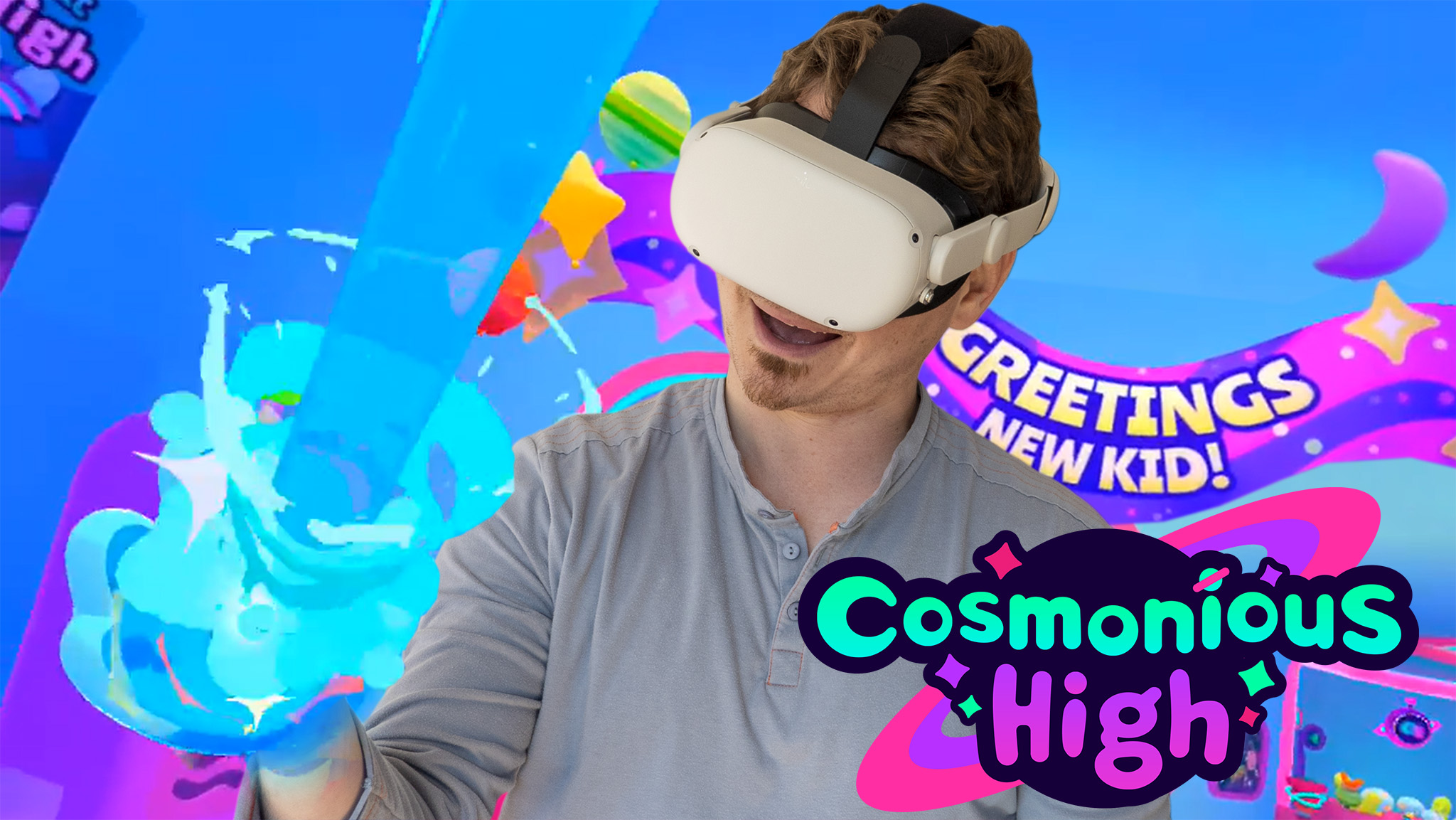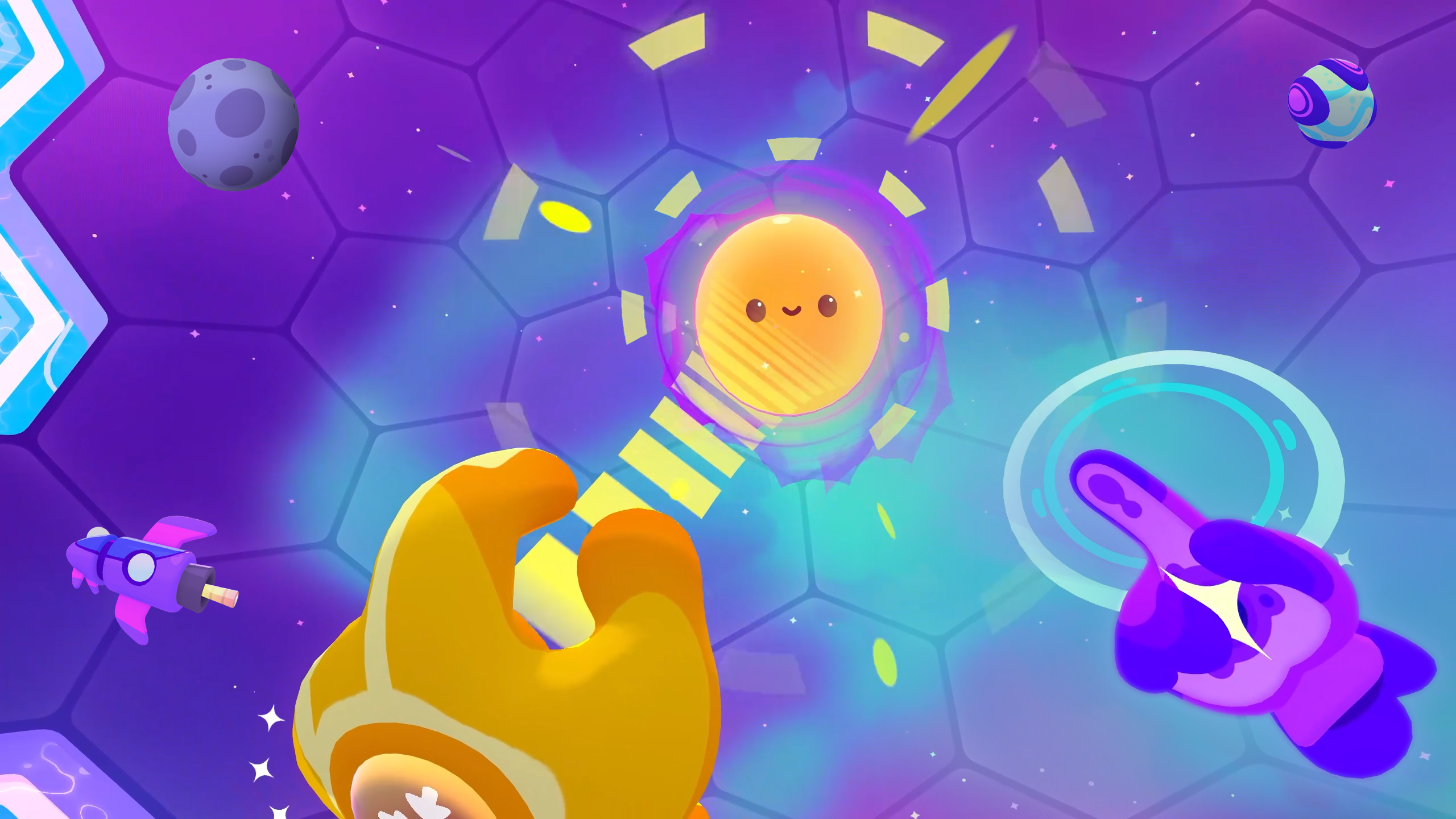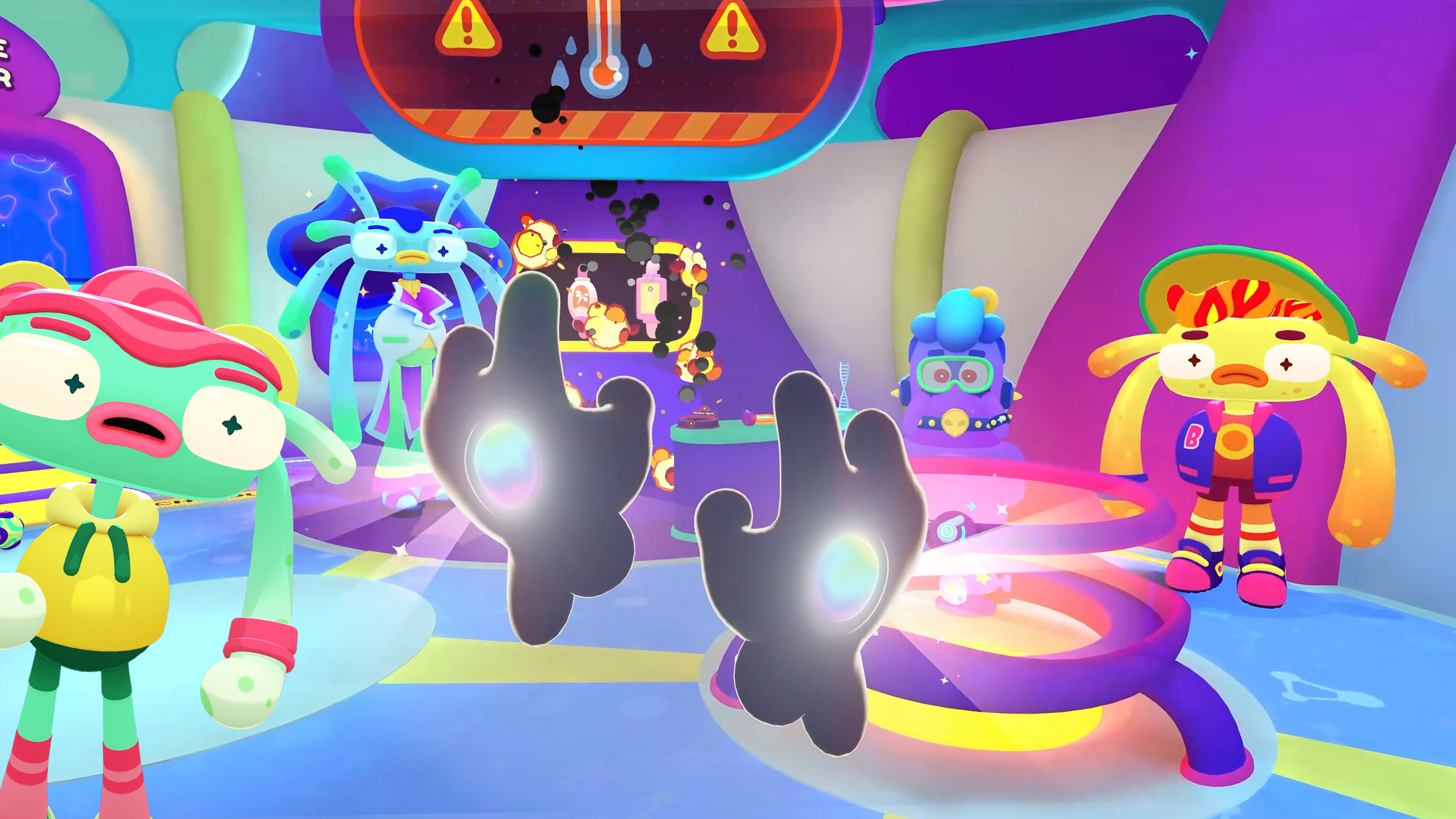Cosmonious High hands-on: Job Simulator for the alien kid in all of us
Owlchemy Labs' successful formula works just as well in other galaxies

Owlchemy Labs is one of the most revered names in the VR business for a reason. The company consistently puts out high-quality, incredibly accessible games with tons of replayability. It should come as no surprise, then, when I realized that Cosmonious High left a smile on my face during the entirety of my playthrough.
That’s because Owlchemy Labs approaches interactions a bit differently than you might expect from a video game developer. Because VR is such an interactive medium, Owlchemy Labs goes out of its way to prototype every possible interaction point a user could perceive.
Yes, that even includes pouring coffee into your magic alien hands and shooting copious amounts of liquid into other aliens’ mouths. It's one of the reasons Owlchemy Labs' games typically end up on our list of best Quest 2 games.
Aside from my playthrough — which lasted about 2 hours and consisted of about 20% of the final game, according to Owlchemy Labs — I sat down virtually with Chelsea Howe, the product director for Cosmonious High to find out more about how the game was designed and what makes Owlchemy Labs’ games so unique in the VR space.
So what is Cosmonious High and does it hold up to the level of polish we expect from Owlchemy Labs? You’ll find out our in our Cosmonious High hands-on below.
For this hands-on, I played Cosmonious High on an Oculus Quest 2 headset using a special preview demo provided by Owlchemy Labs.
The Basics
Cosmonious High puts players in the shoes of a Prismi, a unique class of alien that can absorb elements and other powers in order to adapt to the situation at hand. During your time at Cosmo High, you’ll gain several powers that can be quickly swapped between, including the ability to have separate powers for each hand.
Get the latest news from Android Central, your trusted companion in the world of Android
Owlchemy Labs prides itself on the accessibility of its games, and the mechanics found in Cosmonious High are as straightforward and friendly as they could possibly be. Each of your hands has a “button” on the back which makes it two quick taps to switch between powers.
Each classroom you visit will have a number of assignments that need to be completed, but players can experiment at their own pace.
The backpack mechanic from Vacation Simulator has returned, complete with the sliders and buttons at the bottom to pull up the game’s settings and other menus. Players can grab any object in the environment and put it in their backpacks, granting the ability to bring said objects anywhere in the school.
That ability means players can take the chemicals they make in the Chemosophy Lab into the Visualetics art room and have free reign to make art with sticky paintbrushes, super-bouncy balls, and coffee-fueled hand cannons that’ll get your schoolmates running in hyperactive circles.
Each classroom you visit will have a number of assignments that need to be completed — just as you would expect in a real school — with a class led by a professor in each classroom. These assignments help players get acquainted with the unique gameplay mechanics found in each of the school’s rooms. Additional bonus objectives can be completed in each room, and a number of secrets can be unlocked through experimentation.

Players can chat with other aliens they find throughout the school by pulling a speech bubble out of their mouths. It works exactly as you would imagine, and responses are all contextual and simple to understand. During conversations, tapping the happy face will return a happy response. Other times, you might begin a conversation by tapping an object inside a speech bubble, instead.
In total, the demo I played had three powers: water, ice, and crystal. Each of these powers emits from the palm of your hand and is activated by pressing the X or A button — that’s the bottom button on the face of either controller, depending on which hand you use — which you can then aim anywhere you’d like.
Just as with Vacation Simulator and Job Simulator before it, Cosmonious High features a bevy of accessibility features that’ll help cater to gamers of all abilities and sizes.
Additionally, players can easily grab objects that are too far away by using the distance grab mechanic. If you’ve ever played Half-Life: Alyx, you’ll know how this works. Reach toward any object and you’ll see it outlined in yellow. Grab it by holding down the grip button on the controller you’re reaching with and pull the object toward you. It’ll convincingly fly in your direction and make it easy to quickly grab without having to teleport nearer or bend down to get it.
Just as with Vacation Simulator and Job Simulator before it, Cosmonious High features a bevy of accessibility features that’ll help cater to gamers of all abilities and sizes. From the small human mode to several different comfort options, just about everyone should find that playing Cosmo is comfortable and fun the entire way through. Howe even told me that additional accessibility options should make their way to the game after launch.
The grand scale of the universe

While Owlchemy Labs' previous games were fully grounded on planet Earth, Cosmonious High takes place somewhere in the deep reaches of outer space. As such, the team was able to create a uniquely-shaped high school that doesn’t quite fit what we expect from one on Earth.
It’s the biggest game the team has ever made — both in scope and size — and that includes things like the ability to completely free-roam the school at will. Previous Owlchemy Labs games were either stationary — as with Job Simulator, where you work within the confines of a small space — or with pre-decided spots that you can warp to around the world, as in Vacation Simulator.
It’s the biggest game the team has ever made — both in scope and size — and that includes things like the ability to completely free-roam the school at will.
This time around, players can teleport anywhere they’d like. There’s no smooth walking option — which feels like a bit of a missed opportunity to me — but I'm glad we can at least move around freely. Owlchemy Labs tells me that this was done to reduce motion sickness and other issues that some players experience.
Similarly, the environment around you is completely interactive, and just about anything your mind conceives can be done. Want to paint the walls a different color? Just dip your hand in the paint bucket, absorb the color, and hold the controller’s A or X button to spray to your heart’s content.
That same level of interaction between objects extends to things like bouncy balls or sponges — known as Blebs — which can be tossed around the room and will paint anything they touch in a nice splat shape. Soon enough, the room is covered in paint from top to bottom, with colors blending in convincing ways even on the Quest 2, where these types of technical hurdles aren’t always found. It’s a bit reminiscent of Splatoon, just with fewer squids.
When I spoke with Chelsea Howe about how the team comes up with these scenarios, she laid out an entire process the team goes through from start to finish.
“So we knew that we wanted this to be an alien High School," Howe said. "And once we got the idea of a high school we thought ‘okay, what are people's expectations of high school?' What's the most iconic class you could imagine? For us, it was very much like a science class. So we prototyped out, you know, how many students should be in a classroom? What should the teacher be like? Should there be a teacher? How do you get assignments? Do you have homework do you turn things in? Basically, anything you can think of associated with a science classroom we prototyped in some shape or form.”
While there are a preset number of elements you can discover, what you can do with them is completely up to your imagination.
In the Chemosophy classroom — that’s the science classroom, for note — you’ve got a full chemistry set to work with, which can be used to pair elements together and create new ones either by heating or freezing and then stirring the mixture.
While there are a preset number of elements you can discover, what you can do with them is completely up to your imagination.
One of the elements, Stickium, does exactly what it says on the tin. By applying Stickium to any object in the world, you’ll give it adhesive properties that can be used to combine it with other objects. Likewise, Bouncium will make any object bounce around with glee as you launch it across the room.
Howe told me that that concept of key item transformations — that’s taking an object that’s important to the game world and combining it in an unexpected way with another world object — topped out at around half a dozen options in Vacation Simulator. With Cosmo, the number of transformations has been exponentially raised thanks to the creation of fluids that can be applied to objects.
As with Vacation Simulator, Howe told me that Owlchemy Labs created a “giant helix of items” and paired them together in testing to ensure that every possible combination of items in the game was achievable by a clever player who might think differently from others.
And that’s the real joy of the game. It isn’t so much about following the story mode or completing the missions — although, they are a heck of a lot of fun, from what I’ve experienced so far — rather, it’s in the ways you can explore and create new things.
It’s a game made for the imagination, much as Owlchemy Labs’ previous titles were. After all, Job Simulator was less about properly doing the job of a store clerk or a mechanic and more about how much you could turn each situation upside-down.
Visuals that assault your senses

As I entered Cosmonious High for the first time, my eyes were filled with the entirety of the color spectrum all at once. From the deep purples and blues of space to the vibrant colors of the aliens themselves, this is an incredibly colorful game that’s going to assault your visual senses in all the right ways.
The aliens were playfully animated in a way you would expect from a high-quality CG movie. The effects were impressive in every way, and not just because Owlchemy Labs was able to get them working properly on the relatively underpowered Quest 2 hardware. This game looks good, and it feels like a cohesive experience all the way through.
There’s little doubt that some will wonder about the perceived younger audience scope because of the bright colors and art style.
But there’s little doubt that some will wonder about the perceived younger audience scope because of the bright colors and art style. Without trying to reignite the “kiddie graphics” nonsense argument during the N64 time period, I wonder if the playful art style will turn some players off from even trying it in the first place.
So long as the colorful nature of the world isn’t a turn-off to you, there’s so much joy to experience here. Really, you’d be remiss to not at least give it a shot if you enjoyed Job Simulator or Vacation Simulator. Cosmonious High feels like the next logical step, in terms of mechanics and world design, after those two games.
Look for Cosmonious High to launch this spring on the Quest Store and on SteamVR.

